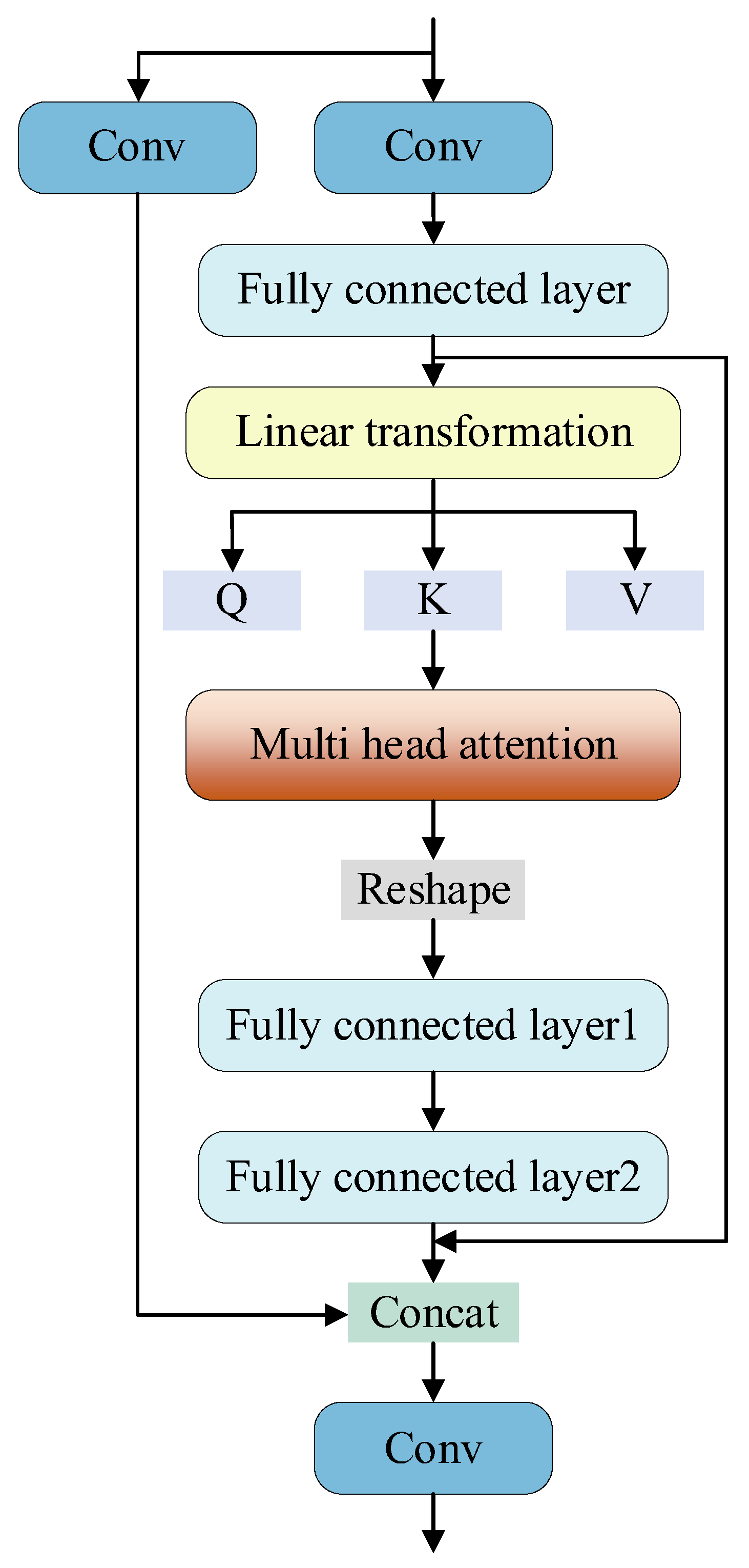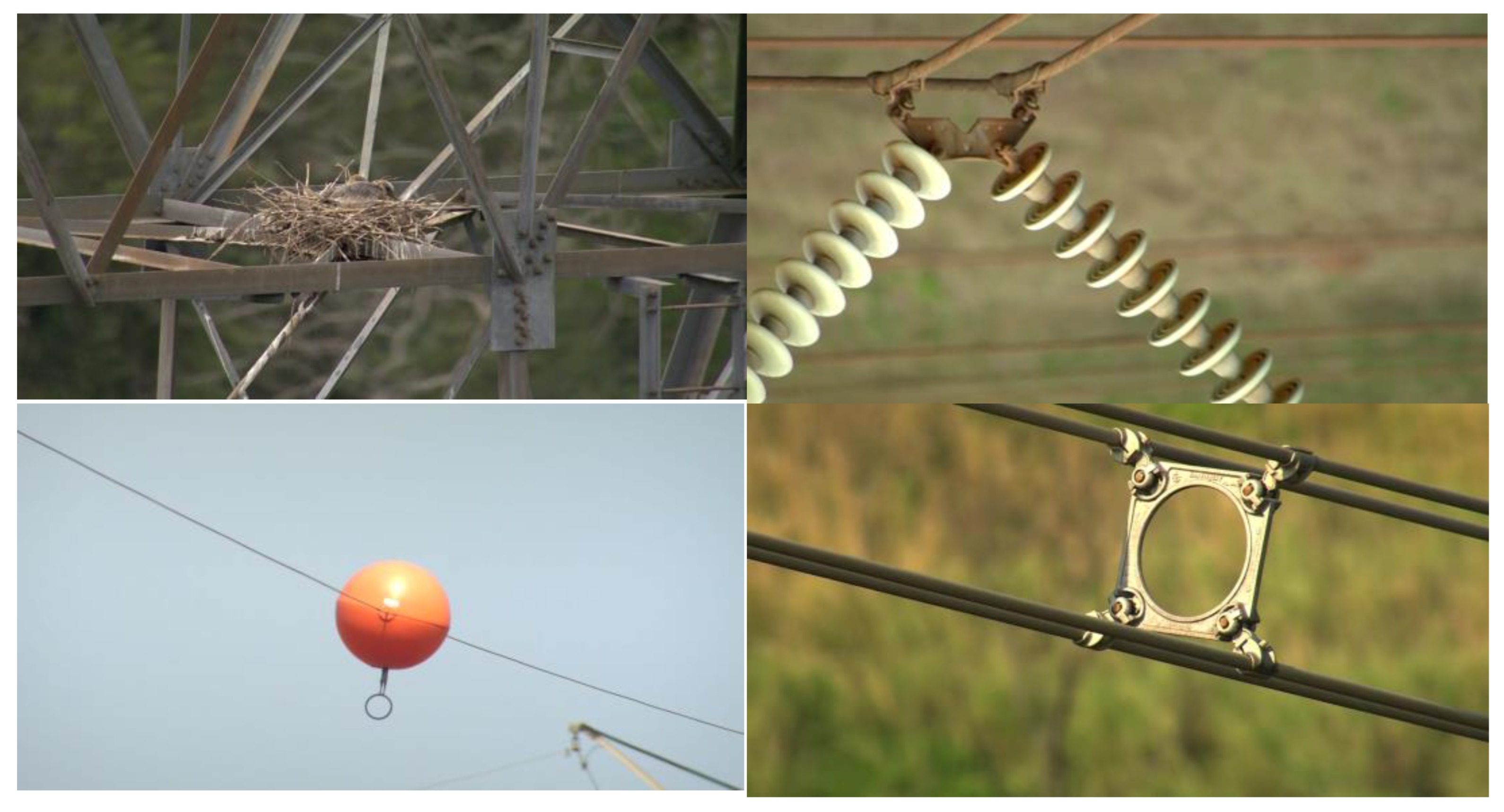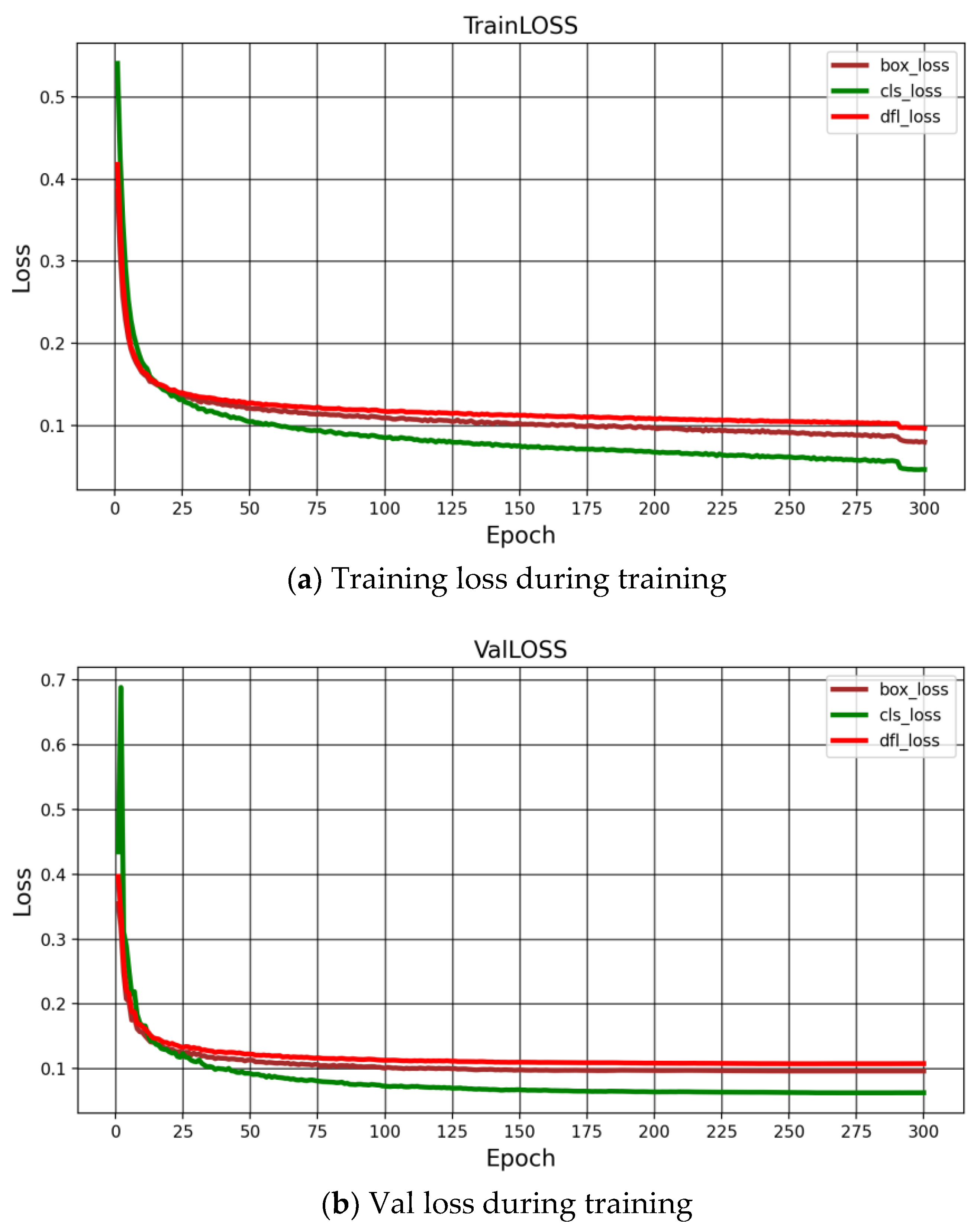Object Detection Based on Improved YOLOv10 for Electrical Equipment Image Classification
Abstract
:1. Introduction
- (1)
- The C3TR module is constructed with Transformer for feature extraction. By dynamically weighting input features using the self-attention mechanism, the C3TR module enhances global feature extraction and strengthens the network’s feature-learning capabilities.
- (2)
- The ECA attention mechanism is applied to the YOLOv10 backbone network. The global pooling and redistribution of channel weights in the ECA attention mechanism improve the global representation of the feature map.
- (3)
- Comprehensive experiments are conducted on the proposed model using the electrical equipment dataset, and the results show that the proposed model significantly improves accuracy and robustness compared to other methods.
2. Related Work
2.1. Object Detection
2.2. Attention Mechanisms
3. Methodology
3.1. Improved YOLOv10
3.2. ECA Attention Mechanism
3.3. C3TR Module
4. Experiments
- (1)
- PTL-AI Furnas Dataset: Aerial photography-based datasets. The PTL-AI Furnas Dataset consists of a drone performing image acquisition of electrical equipment in different weather conditions, against different backgrounds. The dataset contains 6295 images of Baliser, Bird nest, Insulator, Spacer, and Stockbridge. These images are courtesy of Furnas, a Brazilian home-generation transmission company. For a detailed description of the dataset see Appendix A. Figure 4 shows some sample images from the dataset [36].
- (2)
- Experimental equipment and result analysis: This experiment was conducted on the Linux system. The processor is the Intel(R) Core (TM) i5-11400F @ 2.60GHz. The GPU uses the NVIDIA GeForce RTX 3080 Ti, CUDA11.3. This deep learning network framework leverages PyTorch, and Python3.8. Training outcomes may vary depending on the equipment used.
5. Conclusions
Author Contributions
Funding
Data Availability Statement
Conflicts of Interest
Appendix A
Descriptive Statistics of the PTL-AI Furnas Dataset
- Dataset Name: PTL-AI Furnas Dataset
- Total Number of Images: 6295
- Image Resolution: 1280 × 720
- Number of Annotated Components: 17,808
- Classes: Insulator, Baliser, Bird Nest, Spacer, Stockbridge
References
- Jiang, Q.; Liu, Y.; Yan, Y.; Deng, J.; Fang, J.; Li, X.; Jiang, X. A Contour Angle Orientation for Power Equipment Infrared and Visible Image Registration. IEEE Trans. Power Deliv. 2021, 36, 2559–2569. [Google Scholar] [CrossRef]
- Li, F.; Xin, J.; Chen, T.; Xin, L.; Wei, Z.; Li, Y.; Zhang, Y.; Jin, H.; Tu, Y.; Zhou, X.; et al. An Automatic Detection Method of Bird’s Nest on Transmission Line Tower Based on Faster_RCNN. IEEE Access 2020, 8, 164214–164221. [Google Scholar] [CrossRef]
- Saleem, Y.; Crespi, N.; Rehmani, M.H.; Copeland, R. Internet of Things-Aided Smart Grid: Technologies, Architectures, Applications, Prototypes, and Future Research Directions. IEEE Access 2019, 7, 62962–63003. [Google Scholar] [CrossRef]
- Yang, L.; Fan, J.; Liu, Y.; Li, E.; Peng, J.; Liang, Z. A Review on State-of-the-Art Power Line Inspection Techniques. IEEE Trans. Instrum. Meas. 2020, 69, 9350–9365. [Google Scholar] [CrossRef]
- Nguyen, V.N.; Jenssen, R.; Roverso, D. Intelligent Monitoring and Inspection of Power Line Components Powered by UAVs and Deep Learning. IEEE Power Energy Technol. Syst. J. 2019, 6, 11–21. [Google Scholar] [CrossRef]
- Ebrahimi, M.; Rastegar, M. Towards An Interpretable Data-driven Switch Placement Model in Electric Power Distribution Systems: An Explainable Artificial Intelligence-based Approach. Eng. Appl. Artif. Intell. 2024, 129, 107637. [Google Scholar] [CrossRef]
- Yan, Y.; Han, Y.; Qi, D.; Lin, J.; Yang, Z.; Jin, L. Multi-label Image Recognition for Electric Power Equipment Inspection Based on Multi-scale Dynamic Graph Convolution Network. Energy Rep. 2023, 9, 1928–1937. [Google Scholar] [CrossRef]
- Zhan, H.; Zhang, J.; Lan, Y.; Zhang, F.; Huang, Q.; Zhou, K.; Wan, C. Adaptive Enhancement of Thermal Infrared Images for High-Voltage Cable Buffer Layer Ablation. Processes 2024, 12, 2543. [Google Scholar] [CrossRef]
- Gong, X.; Yao, Q.; Wang, M.; Lin, Y. A Deep Learning Approach for Oriented Electrical Equipment Detection in Thermal Images. IEEE Access 2018, 6, 41590–41597. [Google Scholar] [CrossRef]
- Zhang, N.; Su, J.; Zhao, Y.; Chen, H. Insulator-YOLO: Transmission Line Insulator Risk Identification Based on Improved YOLOv5. Processes 2024, 12, 2552. [Google Scholar] [CrossRef]
- Gao, C.; Meng, D.; Yang, Y.; Wang, Y.; Zhou, X.; Hauptmann, A.G. Infrared Patch-Image Model for Small Target Detection in a Single Image. IEEE Trans. Image Process. 2013, 22, 4996–5009. [Google Scholar] [CrossRef] [PubMed]
- Fan, C.; Wang, W.; Cui, T.; Liu, Y.; Qiao, M. Research on Impact Prediction Model for Corn Ears by Integrating Motion Features Using Machine Learning Algorithms. Processes 2024, 12, 2362. [Google Scholar] [CrossRef]
- He, K.; Zhang, X.; Ren, S.; Sun, J. Deep Residual Learning for Image Recognition. In Proceedings of the IEEE Conference on Computer Vision and Pattern Recognition, Las Vegas, NV, USA, 27–30 June 2016; pp. 770–778. [Google Scholar]
- Kong, Y.; Shang, X.; Jia, S. Drone-DETR: Efficient Small Object Detection for Remote Sensing Image Using Enhanced RT-DETR Model. Sensors 2024, 24, 5496. [Google Scholar] [CrossRef]
- Girshick, R.; Donahue, J.; Darrell, T.; Malik, J. Rich Feature Hierarchies for Accurate Object Detection And Semantic Segmentation. In Proceedings of the IEEE Conference on Computer Vision and Pattern Recognition, Columbus, OH, USA, 23–28 June 2014; pp. 580–587. [Google Scholar]
- Ren, S.; He, K.; Girshick, R.; Sun, J. Faster R-CNN: Towards Real-time Object Detection with Region Proposal Networks. IEEE Trans. Pattern Anal. Mach. Intell. 2016, 39, 1137–1149. [Google Scholar] [CrossRef] [PubMed]
- Chen, Z.; Guo, H.; Yang, J.; Jiao, H.; Feng, Z.; Chen, L.; Gao, T. Fast Vehicle Detection Algorithm in Traffic Scene Based on Improved SSD. Measurement 2022, 201, 111655. [Google Scholar] [CrossRef]
- Wang, A.; Chen, H.; Liu, L. Yolov10: Real-time end-to-end object detection. arXiv 2024, arXiv:2405.14458. [Google Scholar]
- Woo, S.; Park, J.; Lee, J.Y.; Kweon, I.S. Cbam: Convolutional Block Attention Module. In Proceedings of the European Conference on Computer Vision (ECCV), Munich, Germany, 8–14 September 2018; pp. 3–19. [Google Scholar]
- Wang, Q.; Wu, B.; Zhu, P.; Li, P.; Zuo, W.; Hu, Q. ECA-Net: Efficient Channel Attention for Deep Convolutional Neural Networks. In Proceedings of the IEEE/CVF Conference on Computer Vision and Pattern Recognition (CVPR), Seattle, WA, USA, 13–19 June 2020; pp. 11531–11539. [Google Scholar]
- Vaswani, A. Attention is all you need. Adv. Neural Inf. Process. Syst. 2017. [Google Scholar]
- Pellicanó, D.; Palamara, I.; Cacciola, M.; Calcagno, S.; Versaci, M.; Morabito, F.C. Fuzzy Similarity Measures for Detection and Classification of Defects in CFRP. IEEE Trans. Ultrason. Ferroelectr. Freq. Control 2013, 60, 1917–1927. [Google Scholar] [CrossRef]
- Morabito, E.C.; Versaci, M. A Fuzzy Neural Approach to Localizing Holes in Conducting Plates. IEEE Trans. Magn. 2001, 37, 3534–3537. [Google Scholar] [CrossRef]
- Sayed, A.; Alshathri, S.; Hemdan, E.E.-D. Conditional Generative Adversarial Networks with Optimized Machine Learning for Fault Detection of Triplex Pump in Industrial Digital Twin. Processes 2024, 12, 2357. [Google Scholar] [CrossRef]
- Fahim, F.; Hasan, M.S. Enhancing The Reliability of Power Grids: A YOLO Based Approach for Insulator Defect Detection. E-Prime—Adv. Electr. Eng. Electron. Energy 2024, 9, 100663. [Google Scholar] [CrossRef]
- Li, S.; Wang, Z.; Lv, Y.; Liu, X. Improved YOLOv5s-based Algorithm for Foreign Object Intrusion Detection on Overhead Transmission Lines. Energy Rep. 2024, 11, 6083–6093. [Google Scholar] [CrossRef]
- Tao, X.; Zhang, D.; Wang, Z.; Liu, X.; Zhang, H.; Xu, D. Detection of Power Line Insulator Defects Using Aerial Images Analyzed With Convolutional Neural Networks. IEEE Trans. Syst. Man Cybern. Syst. 2020, 50, 1486–1498. [Google Scholar] [CrossRef]
- Zhang, Z.D.; Zhang, B.; Lan, Z.C.; Liu, H.C.; Li, D.Y.; Pei, L.; Yu, W.X. FINet: An Insulator Dataset and Detection Benchmark Based on Synthetic Fog and Improved YOLOv5. IEEE Trans. Instrum. Meas. 2022, 71, 1–8. [Google Scholar] [CrossRef]
- Lei, X.; Sui, Z. Intelligent Fault Detection of High Voltage Line Based on The Faster R-CNN. Measurement 2019, 138, 379–385. [Google Scholar] [CrossRef]
- Sadykova, D.; Pernebayeva, D.; Bagheri, M.; James, A. IN-YOLO: Real-Time Detection of Outdoor High Voltage Insulators Using UAV Imaging. IEEE Trans. Power Deliv. 2020, 35, 1599–1601. [Google Scholar] [CrossRef]
- Hu, J.; Shen, L.; Sun, G. Squeeze-and-Excitation Networks. In Proceedings of the IEEE Conference on Computer Vision and Pattern Recognition, Salt Lake City, UT, USA, 18–23 June 2018; pp. 7132–7141. [Google Scholar]
- Li, W.; Qi, F.; Tang, M.; Yu, Z. Bidirectional LSTM with Self-attention Mechanism and Multi-channel Features for Sentiment Classification. Neurocomputing 2020, 387, 63–77. [Google Scholar] [CrossRef]
- Liu, Y.; Lv, B.; Jin, X.; Chen, X.; Zhang, X. TBFormer: Two-Branch Transformer for Image Forgery Localization. IEEE Signal Process. Lett. 2023, 30, 623–627. [Google Scholar] [CrossRef]
- Ganapathi, I.; Javed, S.; Ali, S.; Mahmood, A.; Vu, N.; Werghi, N. Learning to Localize Image Forgery Using End-to-End Attention Network. Neurocomputing 2022, 512, 25–39. [Google Scholar] [CrossRef]
- Wang, J.; Wu, Z.; Chen, J.; Han, X.; Shrivastava, A.; Lim, S.N.; Jiang, Y.G. Object Former for Image Manipulation Detection and Localization. In Proceedings of the IEEE/CVF Conference on Computer Vision and Pattern Recognition (CVPR), Seattle, WA, USA, 13–19 June 2022; pp. 2354–2363. [Google Scholar]
- De Oliveira, F.S.; De Carvalho, M.; Campos, P.H.T.; Soares, A.D.S.; Júnior, A.C.; Quirino, A.C.R.D.S. PTL-AI Furnas Dataset: A Public Dataset for Fault Detection in Power Transmission Lines Using Aerial Images. In Proceedings of the 2022 35th SIBGRAPI Conference on Graphics, Patterns and Images (SIBGRAPI), Natal, Brazil, 24–27 October 2022; Volume 1, pp. 7–12. [Google Scholar]
- Everingham, M.; Van Gool, L.; Williams, C.K.I.; Winn, J.; Zisserman, A. The Pascal Visual Object Classes (voc) challenge. Int. J. Comput. Vis. 2010, 88, 303–338. [Google Scholar] [CrossRef]
- Wang, H.; Liu, C.; Cai, Y.; Chen, L.; Li, Y. YOLOv8-QSD: An Improved Small Object Detection Algorithm for Autonomous Vehicles Based on YOLOv8. IEEE Trans. Instrum. Meas. 2024, 73, 1–16. [Google Scholar] [CrossRef]
- Liu, X.; Du, J.; Gao, X.; Xue, H.; Wu, H.; Ha, R. Electrical Equipment Classification via Improved Faster Region-based Convolutional Neural Network. In Proceedings of the 2024 36th Chinese Control and Decision Conference (CCDC), Xi’an, China, 25–27 May 2024; pp. 5956–5961. [Google Scholar]








Disclaimer/Publisher’s Note: The statements, opinions and data contained in all publications are solely those of the individual author(s) and contributor(s) and not of MDPI and/or the editor(s). MDPI and/or the editor(s) disclaim responsibility for any injury to people or property resulting from any ideas, methods, instructions or products referred to in the content. |
© 2025 by the authors. Licensee MDPI, Basel, Switzerland. This article is an open access article distributed under the terms and conditions of the Creative Commons Attribution (CC BY) license (https://creativecommons.org/licenses/by/4.0/).
Share and Cite
Gao, X.; Du, J.; Liu, X.; Jia, D.; Wang, J. Object Detection Based on Improved YOLOv10 for Electrical Equipment Image Classification. Processes 2025, 13, 529. https://doi.org/10.3390/pr13020529
Gao X, Du J, Liu X, Jia D, Wang J. Object Detection Based on Improved YOLOv10 for Electrical Equipment Image Classification. Processes. 2025; 13(2):529. https://doi.org/10.3390/pr13020529
Chicago/Turabian StyleGao, Xiang, Jiaxuan Du, Xinghua Liu, Duowei Jia, and Jinhong Wang. 2025. "Object Detection Based on Improved YOLOv10 for Electrical Equipment Image Classification" Processes 13, no. 2: 529. https://doi.org/10.3390/pr13020529
APA StyleGao, X., Du, J., Liu, X., Jia, D., & Wang, J. (2025). Object Detection Based on Improved YOLOv10 for Electrical Equipment Image Classification. Processes, 13(2), 529. https://doi.org/10.3390/pr13020529







